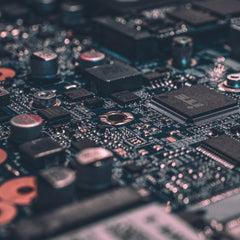Ask our Engineers Anything:
What are the pros and cons of commercial off-the-shelf (COTS) versus custom componentry?
Let’s say you work for a company developing a new product that uses a Serial interface, and you have been tasked with finding a way to integrate Ethernet connectivity. You research all the different options for exports, components that can convert connections like Serial into other interfaces, and come across a number of options.
For example, the Grid Connect RS485 Ethernet Adapter can be purchased directly. This would be the commercial off-the-shelf (COTS) version of the product. However, the protocol on RS485 can also be customized to exactly match the company’s desired specifications. What are the differences between these two options, and what should one think about when the choice between COTS and custom is presented to them?
COTS products:
The nature of COTS products lends a number of benefits. Because a COTS component gets produced on a larger scale, they are standardized, providing identical features across the board. If the specifications provided in the component meet the needs of the customer, then that COTS will make the most business sense, saving time and capital to develop a custom piece. For that same reason, it likely would not be prudent to invest in a custom component for a small volume order.
“You aren’t going to do a custom if you only need a few,” said Rick Rockershousen, Vice President of Sales for GridConnect. “If you can’t find the perfect solution, but if you only need one or two or ten, it often makes more sense to take the nearest thing and work with it.”
Another benefit of COTS products is that they can easily be applied in a trial setting, testing to confirm if the technology achieves the intended goals of the project. That said, because COTS components come standardized, they may have too many features, or be physically unsuitable.
Custom products:
This potential for incompatibility makes COTS components more difficult to use in larger applications. For this reason, Grid Connect offers the ability to customize every component made under their brand name, so each piece can conform perfectly to the desired specifications for the project.
“It could be anything, changing the firmware to hide the configuration of the parts they don’t want. It could be to add things that aren’t in the standard firmware, perhaps like supporting multiple Ethernet connections,” said Rockershousen.
The physical size and shape of each piece are commonly desired to be altered, whether for aesthetic reasons or practical concerns. Take this example of a customer who wanted an export for their new product, but had a physical constraint that required the customization of the export:
“A company that makes airline boarding pass and ticket printers contacted us about a custom version of the NET232. Their printers are serial, but they wanted to have them Ethernet connected,” said Rockershousen. “The customer didn’t have an easy way to plug-in/power the standard NET232, since available outlets are hard to find in airline terminals.”
To rectify this issue, Grid Connect customized the NET232 to receive power from the serial side of the device - so in this case the power is supplied by the printer itself. This resulted in a small, easily installable custom NET232 that converted the serial cable coming off the printer into an Ethernet connection without having to power the new part separately.
One of the biggest pros of customization is the ability to have full control over the user’s end-to-end experience of the product. Customization allows for the component to be branded precisely, allowing the company to determine how much they want the customer to know about how their product comes together. Components can even be added to set their product apart from their competitors.
“It’s a competitive advantage to have something custom that exactly fits the need, where everybody else is using off-the-shelf things to fill it,” said Rockershousen.
Costs for customization vary, but most minor customizations run in the $1,500 to $15,000 range. Things can go up from there if extensive redesign is required to achieve the desired result.
Grid Connect can help with customization of many products, especially those that are under the Grid Connect brand, or include parts from Espressif or Lantronix. Here are just a few:
 |
NET485 Enhanced - Serial to Ethernet Device Server SKU : GC-NET485-ENH MPN : GC-NET485-ENH |
 |
NET232+ Serial to Ethernet Intelligent Cable Adapter SKU : GC-NET232-PLUS MPN : GC-NET232-PLUS |
 |
CANUSB COM FD - USB CAN FD/CAN Interface SKU : GC-CAN-USB-COM-FD-ISO MPN : GC-CAN-USB-COM-FD-ISO |
|
|
GC Enhanced xPICO™ - Serial to Ethernet Embedded Device Server SKU : GC-XPICO-ENH MPN : GC-XPICO-ENH |
 |
ESP32-WROOM-32UE - WI-FI/BT/BLE Module SKU : GC-ESP-WROOM-32UE MPN : ESP32-WROOM-32UE |
Shop all customizable products.
Ultimately, asking questions about the product and application being considered are crucial to making the best possible business decision when it comes to COTS versus custom. Some questions to think about include:
- Do the available COTS products meet the needs of this project?
- How many units of this product are required for the project?
- How time sensitive is this project?
- Do our competitors offer a similar product?
- How much control should be exerted over the end-to-end user experience?
Contact us for more information on how we can help.






